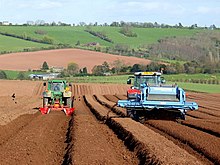Potato planter
A potato planting machine (also known as a potato planting machine) is a special machine for planting potatoes .
Requirements for the planting machine, the planting material and the tractor
A potato planter must allow the tubers to be planted out evenly. The focus is on evenly distributing the planting material on the arable land. What is important is the exact distance between the individual potato ridges , also called bifang in Bavaria , in order to facilitate machine rework. The ridge width must correspond to the usual machine dimensions in order to avoid damage to the crop. It was initially 62 cm, now 68 cm and is currently usually 75 cm. Due to the larger machines, however, the trend is towards 90 cm ridge clearance. A good cover of potatoes is necessary to keep the number of green tubers on the crop as low as possible. Certified seed potatoes are legally limited in their maximum and minimum size so that there are no double occupancies with the standard cups. The track of the tractor is matched to the width of the embankment, the narrow maintenance tires always run between the embankments. With modern machines, the tractor drives across the field with wide tires to support the weight of the planter.
Types
On the loose field, a furrow is drawn by a share and the so-called nut tuber is placed in this at regular intervals. Then a dam is formed over the potato. The planting distance and the planting depth are adjustable.
Semi-automatic (historical)
In the case of semi-automatic devices, the potatoes are placed by hand in a speed-dependent rotating cellular wheel that transports them into the planting hole. This type of device was standard before the 1960s and is now almost only used in specialist companies, e.g. B. nurseries or nurseries used.
Fully automatic
In fully automatic planting machines, the tubers are removed from a storage container by means of a scoop device (scoop chain or bucket belt) and separated by a vibrator or a horizontal runway and then deposited in the furrow.
In order to increase the working speed, scooping devices are implemented twice or three times per potato dam. In some cases, conveyor belts or vibrating sieves are used to gently transport the tubers from the storage container to the scooping device and to increase the loading capacity. Ridge shaping with hollow discs is still common for new potatoes. In this case, dams are partly cut at the time of emergence. In the case of varieties planted later, i.e. mainly varieties for starch and potato chip production , the all-in-one machine is common, which produces the finished dam in one operation. These all-in-one devices can also be combined with rotary harrows . While two- or four-row planting machines are usually operated with three-point attachment, six- to twelve-row machines have an auxiliary axis and can thus accommodate several tons of planting material.
literature
- Agriculture: Volume 3 - Agricultural engineering and construction . BLV Verlagsgesellschaft, Munich, ISBN 3-405-14349-7
- Udo Bols: Agricultural implements for tractors in earlier times . Verlag Podszun-Motorbücher GmbH, Brilon, ISBN 978-3-86133-441-5
Web links
Individual evidence
- ↑ http://www.lgrain.de/kartoffeltechnik/pflanztechnik/pflanzmaschinen_sl_prospekt.pdf ( page no longer available , search in web archives ) Info: The link was automatically marked as defective. Please check the link according to the instructions and then remove this notice. Functional principle of modern machines (sectional drawing) page 2







